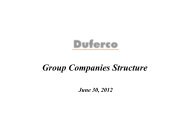Annual Report 2012 EUROPE BELGIUM BULGARIA ... - Duferco
Annual Report 2012 EUROPE BELGIUM BULGARIA ... - Duferco
Annual Report 2012 EUROPE BELGIUM BULGARIA ... - Duferco
Create successful ePaper yourself
Turn your PDF publications into a flip-book with our unique Google optimized e-Paper software.
Strategy<br />
Some countries<br />
of the Eurozone<br />
faced severe<br />
recession and<br />
the 2013<br />
prospects are<br />
certainly not<br />
positive.<br />
The global economic scenario remains<br />
very uncertain. In particular, the market<br />
experienced uncertainty factors caused<br />
by the persisting economical and financial<br />
difficulties in Europe. Some countries<br />
of the Eurozone faced severe recession<br />
and the 2013 prospects are certainly not<br />
positive.<br />
Because of the European crisis, the<br />
International Monetary Fund marked down<br />
growth forecasts for the current year, due<br />
to the weakened global activity and also<br />
the increased risks to the recent historical<br />
level of GDP growth of major dynamic<br />
economies. In spite of this scenario, global<br />
steel production increased, achieving a<br />
new record (more than 1.5 Billion Tons of<br />
steel were produced in <strong>2012</strong>).<br />
Logically, production increased especially<br />
in Asia and China, mainly due to the<br />
ever-increasing fixed assets investment<br />
level. For the near future, however,<br />
such production increase could cause<br />
a significant imbalance of global<br />
overcapacity, especially in China, should<br />
the economies of the developed countries<br />
experience GDP stagnation, and the<br />
developing ones reduce the growth of their<br />
fixed assets investment.<br />
We repeat that the definition of the global<br />
steel market of the last three years can<br />
be, in fact, summarised as a reality of “two<br />
separate worlds”.<br />
In Europe, North America and Japan, GDP<br />
growth is slow, sometimes even stagnant<br />
(the major part of European countries),<br />
while on the other side of the world, there<br />
is a very important GDP growth, especially<br />
in Asia, Latin America and the Middle-<br />
East.<br />
These two separate worlds create a strong<br />
global imbalance, with excess capacity<br />
in the mature industrialized countries and<br />
shortage in the emerging countries.<br />
Value creation in the steel industry<br />
continues to be significantly related to the<br />
control of raw material sources (iron ore,<br />
coking coal and other). The upstream<br />
factors thus determine the economic<br />
performances of industrial assets much<br />
more than the downstream factors.<br />
This represents a reversal of the traditional<br />
fundamentals of the steel industry.<br />
Historically, the market balance was<br />
relatively clear, resulting in a pricing<br />
picture that was predictable, although<br />
not always positive for the steel industry.<br />
Raw material prices were set for the year.<br />
Raw material production was a known<br />
factor, since new investments were scarce<br />
due to the relatively poor outlook of the<br />
mining industry. Similarly, steel demand<br />
was relatively well known and growing only<br />
moderately. All of this changed during the<br />
past decade and is today influencing the<br />
stability of the markets for steel-making<br />
raw material. A huge margin shift from<br />
steel mills to mining has occurred and<br />
the cost curve of the different producers<br />
steepened (large competitive advantage of<br />
steel mills integrated upwards versus the<br />
“orphans”).<br />
The future is uncertain, with a large range<br />
of factors affecting the future supply of<br />
steelmaking raw material.<br />
Apart from the need to develop new<br />
mines, the infrastructures required to<br />
supply raw materials, such as port and<br />
railway connections to loading ports,<br />
are a strong barrier to new projects.<br />
Uncontrollable events, such as adverse<br />
weather conditions, often have an impact<br />
on the supply.<br />
Demand is heavily influenced by China<br />
steel output and Chinese domestic iron<br />
ore production.<br />
10 | <strong>Duferco</strong> <strong>Annual</strong> <strong>Report</strong> <strong>2012</strong>



